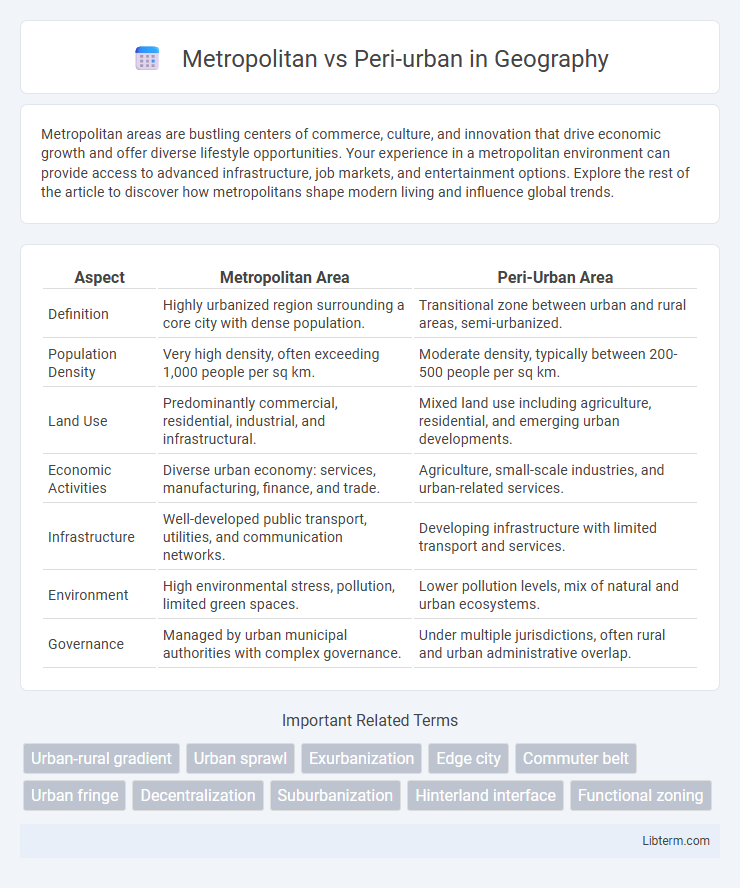Metropolitan areas are bustling centers of commerce, culture, and innovation that drive economic growth and offer diverse lifestyle opportunities. Your experience in a metropolitan environment can provide access to advanced infrastructure, job markets, and entertainment options. Explore the rest of the article to discover how metropolitans shape modern living and influence global trends.
Table of Comparison
| Aspect | Metropolitan Area | Peri-Urban Area |
|---|---|---|
| Definition | Highly urbanized region surrounding a core city with dense population. | Transitional zone between urban and rural areas, semi-urbanized. |
| Population Density | Very high density, often exceeding 1,000 people per sq km. | Moderate density, typically between 200-500 people per sq km. |
| Land Use | Predominantly commercial, residential, industrial, and infrastructural. | Mixed land use including agriculture, residential, and emerging urban developments. |
| Economic Activities | Diverse urban economy: services, manufacturing, finance, and trade. | Agriculture, small-scale industries, and urban-related services. |
| Infrastructure | Well-developed public transport, utilities, and communication networks. | Developing infrastructure with limited transport and services. |
| Environment | High environmental stress, pollution, limited green spaces. | Lower pollution levels, mix of natural and urban ecosystems. |
| Governance | Managed by urban municipal authorities with complex governance. | Under multiple jurisdictions, often rural and urban administrative overlap. |
Defining Metropolitan and Peri-urban Areas
Metropolitan areas are densely populated regions encompassing a central city and its economically integrated suburbs, characterized by extensive infrastructure and diverse urban functions. Peri-urban areas lie at the interface between urban and rural zones, exhibiting mixed land uses with transitional developments, often experiencing rapid growth. Defining these areas involves analyzing population density, land use patterns, economic activities, and spatial integration with urban cores.
Key Characteristics of Metropolitan Regions
Metropolitan regions are characterized by high population density, extensive infrastructure, and significant economic activity, serving as major hubs for commerce, culture, and governance. These areas exhibit complex transportation networks, diverse housing options, and advanced public services supporting large, dynamic populations. In contrast, peri-urban zones surrounding metropolitan cores typically experience transitional land use, lower density, and a blend of urban and rural features.
Distinct Features of Peri-urban Zones
Peri-urban zones are characterized by rapid land-use change, blending rural and urban elements with mixed agricultural and residential activities. These areas exhibit fragmented infrastructure and transitional economies, often marked by irregular urban planning and informal settlements. Unlike metropolitan cores, peri-urban zones face unique challenges such as environmental degradation, limited access to services, and socio-economic disparities.
Urbanization Trends: Metropolitan vs Peri-urban
Metropolitan areas experience rapid urbanization characterized by high population density, extensive infrastructure, and concentrated economic activities, driving significant demand for housing, transportation, and services. In contrast, peri-urban regions exhibit a transitional urbanization pattern, blending rural and urban features with moderate population growth and expanding suburban development. Urbanization trends indicate metropolitan regions often lead in technological advancement and economic output, while peri-urban zones serve as critical buffers accommodating spillover growth and evolving land use dynamics.
Population Density and Demographics
Metropolitan areas typically exhibit high population densities with diverse demographic profiles, including a wide range of age groups, ethnicities, and socioeconomic statuses. Peri-urban zones have moderate to lower population densities featuring transitional demographic characteristics, often showing a mix of urban and rural populations with varying income and education levels. Population growth in metropolitan regions is driven by urbanization and economic opportunities, while peri-urban areas experience demographic shifts due to suburban expansion and migration from rural communities.
Infrastructure and Connectivity Comparison
Metropolitan areas feature highly developed infrastructure with extensive public transportation networks, advanced road systems, and superior digital connectivity, supporting dense populations and economic activities. In contrast, peri-urban regions often face infrastructure deficits, including limited public transit options, underdeveloped road quality, and inconsistent internet access, hindering seamless connectivity and growth. Investment in improving transport links and digital infrastructure in peri-urban zones is critical to bridging the accessibility gap with metropolitan centers.
Economic Activities and Employment Patterns
Metropolitan areas concentrate diverse economic activities, including finance, technology, manufacturing, and services, supporting a highly specialized and formal employment market with numerous professional, managerial, and technical jobs. Peri-urban regions exhibit mixed economic activities, combining agriculture, small-scale industries, and informal sector jobs, often characterized by lower wage levels and less job security. Employment patterns in metropolitan zones tend to be more stable and skill-intensive, whereas peri-urban areas face greater employment fluctuations and reliance on part-time or casual labor.
Land Use and Environmental Impact
Metropolitan areas typically exhibit high-density land use characterized by extensive residential, commercial, and industrial developments, leading to significant environmental impacts such as air pollution and habitat fragmentation. Peri-urban zones, transitional spaces between urban and rural, often experience mixed land use with agricultural activities interspersed with emerging urban infrastructure, causing challenges like uncontrolled urban sprawl and increased resource consumption. The environmental impact in peri-urban areas includes loss of biodiversity and soil degradation, driven by unregulated land conversion and inadequate planning controls.
Governance and Urban Planning Challenges
Metropolitan areas face complex governance challenges due to overlapping jurisdictions and fragmented administrative structures, complicating integrated urban planning and service delivery. Peri-urban regions experience rapid, unregulated growth that strains infrastructure and leads to inconsistent land-use policies, making coordinated governance difficult. Both contexts require adaptive planning frameworks to address spatial fragmentation, resource allocation, and sustainable development goals effectively.
Future Growth and Development Perspectives
Metropolitan areas are projected to experience concentrated population growth driven by technological advancements, economic diversification, and infrastructure upgrades, fostering sustainable urbanization and enhanced global connectivity. Peri-urban zones exhibit dynamic expansion due to urban sprawl, increasing demand for affordable housing, and mixed land use, necessitating integrated planning to balance urban and rural functions effectively. Future development strategies emphasize smart growth, resilient infrastructure, and inclusive policies to manage environmental impacts and socio-economic disparities across metropolitan and peri-urban regions.
Metropolitan Infographic

 libterm.com
libterm.com